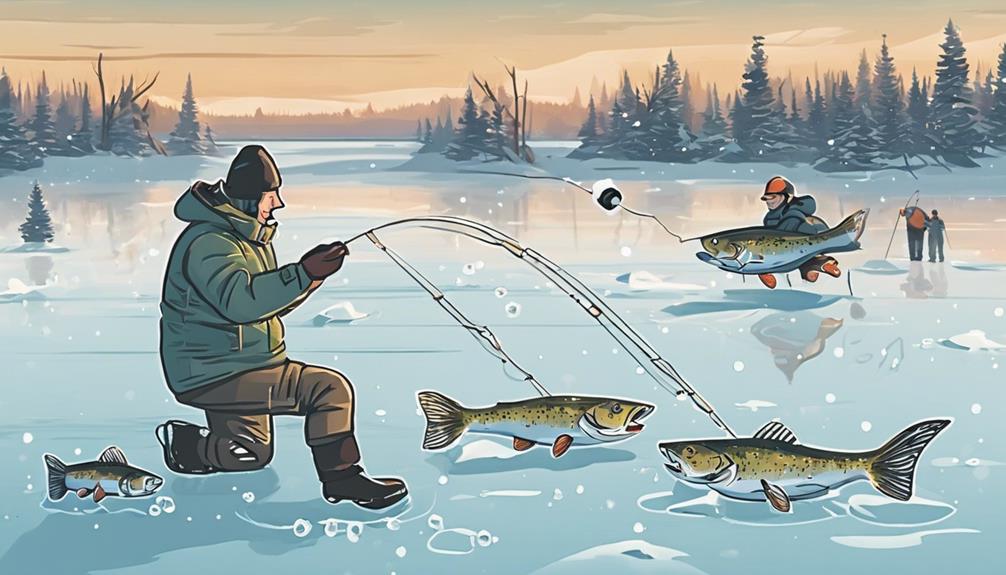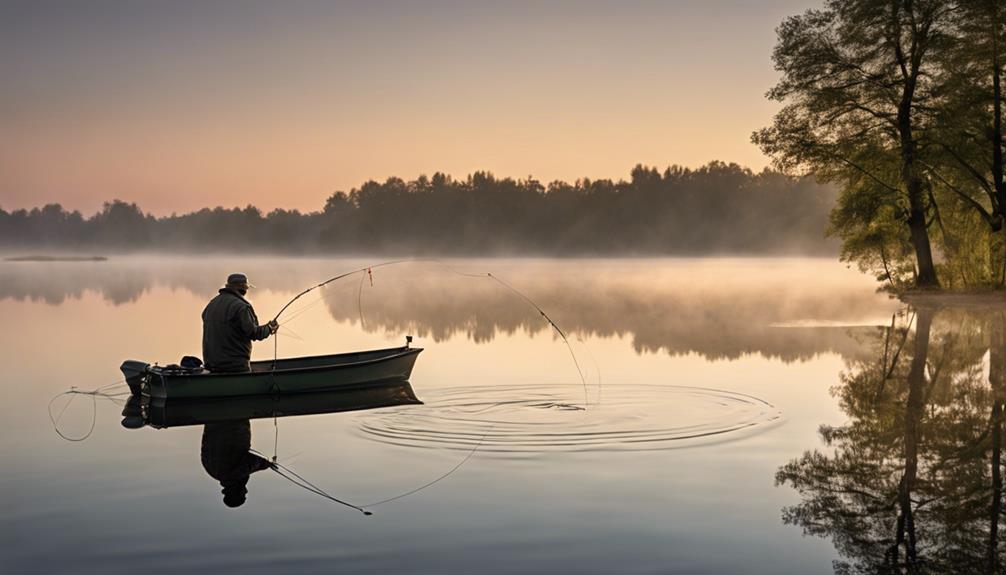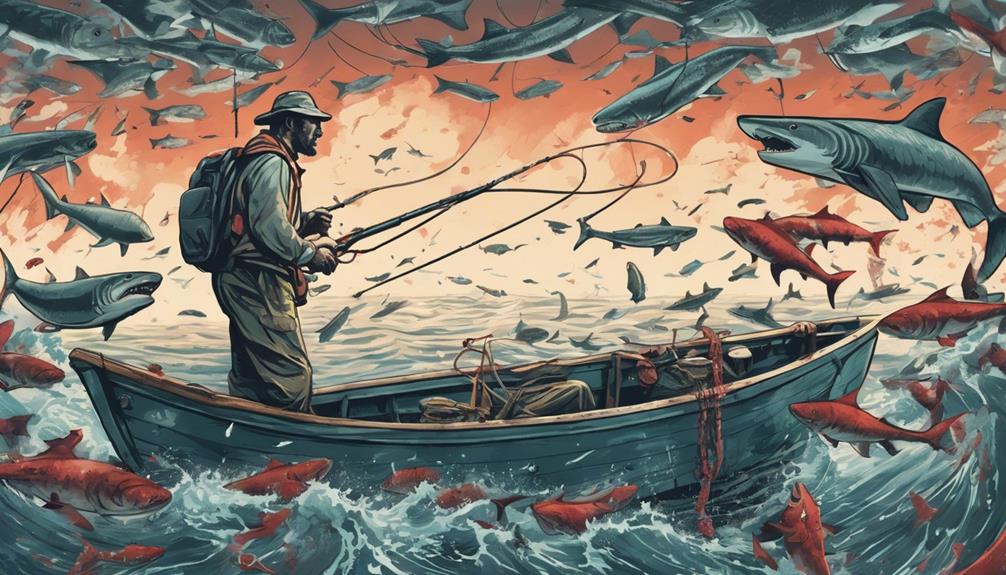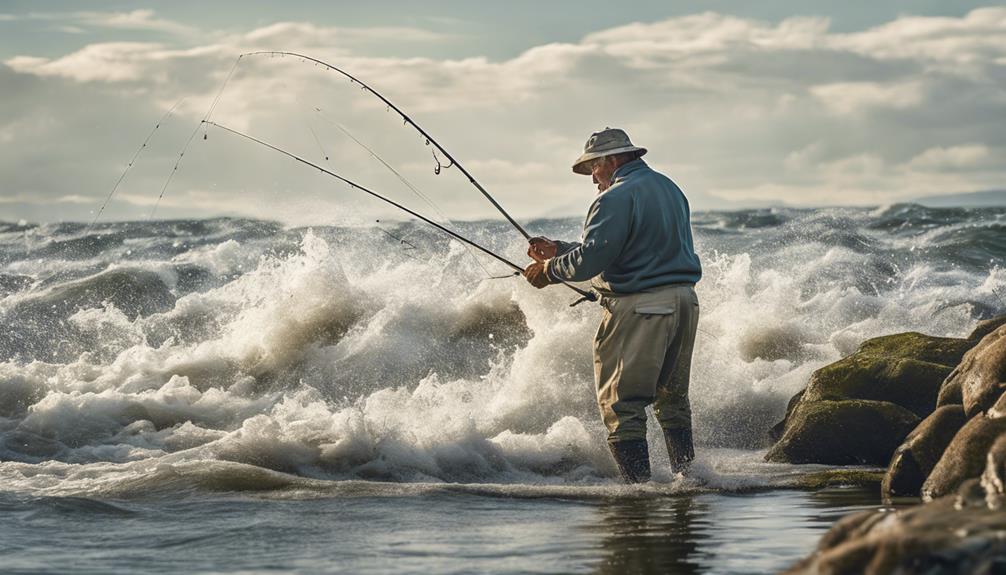Are you tired of coming back empty-handed from your pike ice fishing trips?
Discover the essential techniques that can turn the tide in your favor.
From mastering the art of jigging to strategically placing your tip-ups, these methods will elevate your ice fishing game to new heights.
Stay tuned to uncover the secrets behind successful pike ice fishing and maximize your chances of landing that elusive trophy catch.
Jigging Techniques
To maximize your chances of success while ice fishing for pike, mastering effective jigging techniques is essential. When it comes to depth variations, adjusting your jigging depth is crucial. Pike can be found at various depths depending on the time of year and weather conditions. Use a fish finder to locate them, then experiment with different depths until you find where they're biting. As for lure selection, opt for larger lures that mimic the pike's natural prey. Brightly colored spoons or swimbaits can be effective in attracting their attention.
Speed control is another key aspect of jigging. Pike are known to be aggressive predators, so a fast jigging motion can trigger their predatory instincts. However, they can also be picky at times, so don't hesitate to vary your jigging speed until you find what works best. When a pike strikes, proper hook setting is crucial. Make sure to set the hook firmly and quickly to ensure a good hook-up. Pike have tough mouths, so a strong hook set is necessary to prevent them from shaking the hook loose.
Tip-Up Strategies
Maximize your success in ice fishing for pike by implementing effective tip-up strategies. When setting up your tip-up, ensure proper line tension to detect any slight movements or bites. Setting the line too tight can make it difficult for the pike to grab the bait without feeling resistance, while too loose of a line may result in missed opportunities. Finding the right balance is key to increasing your chances of a successful catch.
Consider the wind direction when situating your tip-ups. Position them in areas where the wind will help in signaling a bite. The wind can cause the flag to pop up more noticeably, alerting you to potential action below the ice. Additionally, the direction of the wind can influence how pike move in the water, so strategic placement based on this factor can lead to more bites.
Maintaining optimal line tension and utilizing wind direction to your advantage are crucial components of effective tip-up strategies. By paying attention to these details, you can significantly improve your ice fishing experience for pike. Next, we'll delve into using live bait to further enhance your chances of landing that prized catch.
Using Live Bait
When using live bait for pike ice fishing, consider the type of bait that will entice these predatory fish to strike. Live bait selection plays a crucial role in attracting pike under the ice.
To maximize your chances of a successful pike ice fishing trip, follow these tips:
- Choose the Right Live Bait: Opt for lively and large live baitfish such as suckers, shiners, or large minnows. These larger baits are more enticing to big pike and can tempt them to strike.
- Use Quick Strikes: Consider using quick strike rigs when presenting live bait. These rigs allow for a more natural bait presentation and increase the likelihood of hooking the pike once it strikes.
- Experiment with Depths: Pike can be found at varying depths under the ice, so it's essential to experiment with different depths when presenting live bait. Start by fishing closer to the bottom and gradually adjust your depth until you find where the pike are actively feeding.
- Keep Bait Active: Keep your live bait active and moving to grab the attention of nearby pike. Jig the bait every so often to create movement and make it appear more appealing to these predatory fish.
Understanding Pike Behavior
Understanding pike behavior is key to successfully targeting these predatory fish during ice fishing expeditions. Pike are apex predators, exhibiting aggressive behavior as they establish dominance in their environment. This aggression plays a crucial role in their predator-prey dynamics, allowing them to efficiently hunt and feed on other fish species beneath the ice. By understanding these behavioral traits, anglers can adapt their strategies to attract pike effectively.
Seasonal movement greatly influences pike behavior. During winter, pike tend to be less active, conserving energy in the cold water. However, they still need to feed to survive, making them more likely to strike at bait presented enticingly. Knowing their feeding patterns can help you predict when they're most active, increasing your chances of a successful catch.
Pike are known for their ambush hunting style, preferring to lurk near underwater structures or vegetation where they can hide and surprise their prey. When setting up your ice fishing spot, consider these habitat preferences to increase your chances of attracting pike. Understanding how pike behavior changes in response to different factors like temperature and light conditions can give you the edge in outsmarting these elusive predators. By leveraging this knowledge, you can optimize your ice fishing techniques for a more rewarding experience on the frozen waters.
Hole Placement Tips
To increase your chances of a successful catch while ice fishing for pike, strategic placement of your fishing holes is crucial. When it comes to hole placement tips, consider the following:
- Depth Adjustment: Pike tend to swim at different depths depending on factors like temperature and light. To target them effectively, adjust your hole's depth by drilling multiple holes at various depths until you find where the pike are active. Ensure you have the right equipment choice, such as a sonar device, to help determine the depth accurately.
- Wind Direction: Take note of the wind direction when drilling your holes. Pike often follow the movement of their prey carried by the current created by the wind. By positioning your holes in the direction where the wind is blowing, you increase the chances of pike swimming towards your bait.
- Hole Preparation: Before dropping your line, make sure to clear the ice shavings and slush from the hole. This helps prevent interference with your bait and ensures a clear path for the pike to approach.
- Spacing: When drilling multiple holes, space them out strategically. This allows you to cover a larger area and increases the likelihood of attracting pike from different locations under the ice.
Setting Up Shelter Correctly
For optimal comfort and protection while ice fishing for pike, ensure your shelter is set up securely and efficiently. Shelter insulation is crucial in keeping you warm during those long hours on the ice. Choose a shelter with good insulation properties to retain heat and create a cozy environment inside. Additionally, consider adding insulating materials like foam mats or thermal blankets to the floor of your shelter for extra warmth.
Wind protection is another key aspect when setting up your shelter. Position your shelter in a way that the entrance faces away from the prevailing wind direction. This won't only reduce drafts inside but also prevent the wind from blowing snow or debris into your shelter. Utilize windbreaks like snow walls or portable windbreak panels to further shield your shelter from strong gusts.
When setting up your shelter, ensure it's securely anchored to the ice to prevent it from shifting or collapsing in case of strong winds. Use ice anchors or heavy-duty stakes to secure the corners and edges of your shelter firmly into the ice. Regularly check the anchoring points to make sure they remain secure throughout your ice fishing expedition.
Proper Gear Selection
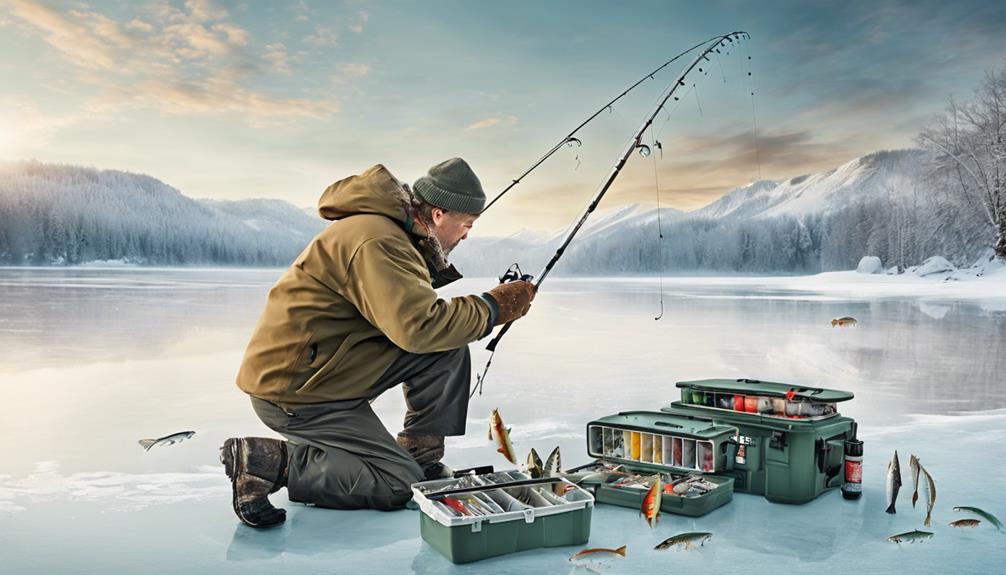
When gearing up for pike ice fishing, make sure you select equipment tailored to the specific needs and challenges of ice angling. Proper gear selection is crucial for maximizing your chances of success on the frozen waters. Here are some key points to consider:
- Choose the Right Rod and Reel: Opt for a sturdy medium to heavy-action rod paired with a high-quality reel that can withstand the harsh conditions of ice fishing. A smooth drag system is essential for handling the powerful runs of pike.
- Select Appropriate Line and Leaders: Use braided lines for better sensitivity and to handle the abrasiveness of ice edges. Pair your line with a fluorocarbon leader to prevent bite-offs from pike's sharp teeth.
- Pick the Correct Lures: Select larger-sized lures such as spoons, jigs, or swimbaits designed to attract pike. Bright colors and flashy patterns tend to be more effective in murky waters.
- Maintain Your Gear Regularly: Keep your equipment in top condition by performing regular maintenance. This includes cleaning your rods and reels after each use, checking for any wear and tear, and ensuring all components are functioning correctly.
Safety Measures to Consider
Considering the importance of staying safe while ice fishing for pike, it's essential to be aware of key safety measures to protect yourself on the frozen waters. Safety precautions are crucial when venturing onto the ice. Always ensure that the ice thickness is at least 4 inches for safe fishing. However, for heavier equipment like trucks or large groups, the ice should be at least 8-12 inches thick. Before heading out, check with local authorities or experienced anglers about the current ice conditions and any potential hazards to watch out for.
Another vital safety measure is to never fish alone. Always bring a buddy along and inform someone on land about your fishing plans, location, and expected return time. In case of an emergency, having someone aware of your whereabouts can expedite rescue efforts. Additionally, wear appropriate clothing to stay warm and dry, including insulated waterproof boots, gloves, and multiple layers of clothing.
Carrying safety gear like ice picks, a floating rope, and a life jacket is non-negotiable. These items can be lifesaving in the event of an accidental fall through the ice. Remember, safety should always be the top priority when engaging in any winter fishing activities. Stay cautious, be prepared, and enjoy your pike ice fishing adventure responsibly.
Frequently Asked Questions
What Are the Best Times of Day to Ice Fish for Pike?
When ice fishing for pike, early morning and late afternoon are ideal times. Pay attention to moon phases, as they can affect pike activity. Being out on the ice during these times increases your chances of a successful catch.
How Can Weather Conditions Affect Pike Ice Fishing Success?
Weather conditions play a crucial role in pike ice fishing success. Temperature fluctuations can influence pike activity levels, while ice thickness determines safety.
Wind speed affects the distribution of pike under the ice, and visibility impacts your ability to spot potential fishing spots.
Being aware of these factors and adjusting your strategies accordingly can greatly improve your chances of a successful ice fishing expedition for pike.
What Are Some Common Mistakes That Beginner Ice Fishermen Make When Targeting Pike?
When targeting pike as a beginner ice fisherman, common misconceptions can lead to mistakes. It's crucial to understand that proper gear is essential for success. Some mistakes include using the wrong size of bait, not adjusting to the depth where pike are located, and not being patient enough.
Make sure to have the right equipment and be prepared to adapt your techniques to increase your chances of a successful pike ice fishing experience.
Are There Any Specific Regulations or Restrictions for Ice Fishing for Pike in Certain Areas?
In certain areas, regulations and restrictions may apply to ice fishing for pike. It's crucial to be aware of these rules to ensure you're fishing legally and responsibly.
Always check local fishing regulations for any specific guidelines regarding pike fishing on the ice. Safety should also be a top priority when engaging in this activity, so make sure to have the right equipment and knowledge before heading out.
How Can Anglers Locate Prime Pike Fishing Spots on Frozen Lakes or Rivers?
To locate prime pike fishing spots on frozen lakes or rivers, start by exploring the depths and analyzing the structures underwater. Look for areas with varying depths, such as drop-offs, weed beds, or rocky points, as pike tend to gather there.
Drill holes and use a fish finder to locate schools of fish. Keep moving around until you find active feeding pike. Experiment with different baits and techniques to maximize your chances of a successful catch.
Conclusion
Now that you have learned the best techniques for successful pike ice fishing, get out there and put them to use!
Remember to jig effectively, utilize tip-ups, use live bait, understand pike behavior, place your holes strategically, set up shelter properly, select the right gear, and prioritize safety.
With these tips in mind, you'll increase your chances of a successful day on the ice catching pike.
Happy fishing!
